MV Dirona travel digest for Liverpool 2017

|
Click the travel log icon on the left to see these locations on a map,
with the complete log of our cruise. On the map page, clicking on a camera or text icon will display a picture and/or log entry for that location, and clicking on the smaller icons along the route will display latitude, longitude and other navigation data for that location. And a live map of our current route and most recent log entries always is available at //mvdirona.com/maps/LocationCurrent.html. |
 |
10/29/2017: Golden Reaper
Position: 54°38.49'N, -5°26.38'W
Around 11:30pm, two hours out of Belfast, we made a course adjustment to avoid the fishing vessel Golden Reaper who was crossing our path on a near-collision course. We aim for a two-mile CPA (Closest Point of Approach) from other vessels at night, but the traffic in busier areas often makes it difficult to find two free nautical miles. Here we barely achieved one nautical mile (see bottom of right column). Most fishermen will give you room to work, especially at night, but not all.
|
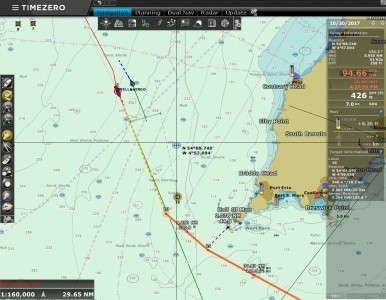 |
10/30/2017: Calf of Man
Position: 54°19.12'N, -5°9.72'W
We saw a fair bit of traffic rounding the Calf of Man off the southwest tip of the Isle of Man. Here we are passing Tella Virgo with about one-mile separation and have an ARPA target approaching with a two-mile CPA. We continue to be impressed with the new CPA bars of our TimeZero chart-plotter.
If we had a few more days, we would have stopped at the Isle of Man, but we wanted to reach Liverpool by October 30th to make a trip to Manchester. |
 |
10/30/2017: Dawn
Position: 53°54.51'N, -4°32.70'W
Conditions have been ultra-calm on this run from Belfast to Liverpool, with hardly any wind at all. The seas remain calm at dawn.
|
 |
10/30/2017: Stena
Position: 53°48.46'N, -4°14.67'W
One of several Stena ferries we passed on the run between Belfast and Liverpool.
|
 |
10/30/2017: Burbo Bank Extension
Position: 53°39.00'N, -3°43.23'W
All those radar targets at the bottom of the screen are the windmills in the Burbo Bank Extension. The 258MW extension was completed this year, nearly quadrupling the output of the original farm from 90MW to 348 MW.
|
 |
10/30/2017: Sea Titus
Position: 53°38.75'N, -3°42.30'W
Offshore supply vessel Sea Titus at an oil rig near the Burbo Bank Wind Farm.
|
 |
10/30/2017: Skyline
Position: 53°37.52'N, -3°37.86'W
Wind mills and oil rigs to our south as we near the mouth of the Mersey River.
|
 |
10/30/2017: Slow
Position: 53°35.34'N, -3°29.89'W
The lock at the entry to Liverpool Marina requires 21ft of tide to open, so we can only enter about two hours on either side of high tide. We have been running at about 6 kts on this passage from Belfast to avoid arriving too early.
|
 |
10/30/2017: Burbo Bank
Position: 53°31.40'N, -3°15.61'W
Windmills in the original 90 MW Burbo Bank wind farm, built in 2007.
|
 |
10/30/2017: Pilot
Position: 53°31.53'N, -3°10.88'W
Pilot boat exiting the Mersey River.
|
 |
10/30/2017: City of Cardiff
Position: 53°31.59'N, -3°8.33'W
We're seeing lots of traffic as we enter the Mersey River. The dredger City of Cardiff passed heading inbound.
|
 |
10/30/2017: Channel 37
Position: 53°29.94'N, -3°5.92'W
We need to pass through the Brunswick Lock to reach our destination, the Liverpool Marina. As we approached, we got ready to radio the lock keeper on channel 37 according to their published procedures. It turns out we don't have channel 37 on our primary Icom MC-604 radios. Of course they do have US, CAN, and INTL frequency choices but none have channel 37. We checked our Standard Horizon and ICOM hand-held VHFs and they don't support channel 37 either. We did some research and found that the UK uses channel M (157.850Mhz also called 37), and channel M2, (161.425Mhz also called P1 or P4) for marinas, yacht clubs and pleasure craft. But radios not sold into the UK market don't support this frequency. In fact, a good many that are sold into the UK market don't support channel 37 either. This frequency seems like a rather unfortunate choice given they are an international port, but little could be done and we needed to come up with a way to contact the lock keeper.
We tried reaching the lock keeper on VHF 16, 13, and 12, the Mersey River Vessel Traffic Frequency, without success. We eventually contacted Mersey Vessel Traffic Services and they got a couple of phone numbers for us. While doing that, the skipper of a commercial vessel that was just entering the Brunswick Lock contacted us and offered to relay to the dock keeper on our behalf. Once we arrived, they told the lock keeper we were ready to enter. The keeper opened the gates and gave us three green lights to enter. When we left a week later, the marina contacted the lock on our behalf, as the lock keeper could only be reached on 37, not by phone. So we managed to make the two way trip without much complexity and appreciated the local help. |
 |
10/30/2017: Port of Liverpool
Position: 53°28.11'N, -3°3.82'W
The Port of Liverpool once was the main terminus for trans-Atlantic traffic between the UK and North America. This dwindled in the 20th-century with the introduction of containerization but has since improved with the construction of a new port in the 1960s that currently handles about a quarter of all container traffic between the UK and USA. The five huge red Megamax cranes visible at the right of the picture dwarf the adjacent cranes and are part of a recent deep-water shipping port project that will increase the capacity of ships that can be handled from those carrying 3,500 containers to 13,500.
|
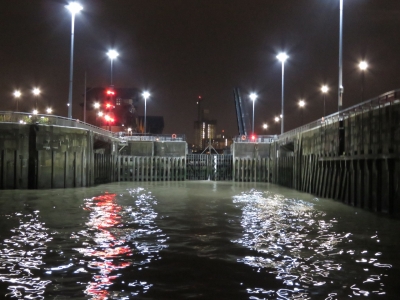 |
10/30/2017: Brunswick Lock
Position: 53°23.14'N, -2°59.07'W
With a tidal range of 32.8 ft (10 m) on spring tides, the River Mersey has the second highest tidal range in Britain after the River Severn. The Mersey River banks dry at low tide, so most of the commercial docks are behind locks. In 1715, the world's first enclosed commercial dock was built in Liverpool and additional docks and locks were constructed over the subsequent centuries. Even the new port built is behind a lock, which had the largest gates in the world when completed in 1971. As we approached, Mersey Vessel Traffic was announcing the "Ships Movement", listing the name and time that each ship would passing through a given lock.
The original docks and locks are too small for most commercial shipping vessels and now are used mainly for pleasure craft and smaller commercial boats. Our destination, Liverpool Marina, is in an old commercial basin accessed through Brunswick Lock. With our draft, the earliest we could enter the lock is with 22ft of tide, which unfortunately was well after dark at 5:45pm. Not the ideal time to be approaching an unfamiliar area and entering a lock, but we didn't have much choice unless we waited until tomorrow morning. The weather would have been worse for the crossing from Belfast if we did that, so we opted for a night entry instead. Fortunately the lock is well-lit and wasn't difficult to enter at night. |
 |
10/30/2017: Gate Open
Position: 53°23.15'N, -2°59.06'W
A couple of boats locked through before we did, then the outer gates opened for us. At 8m wide the Brunswick Lock gate we can easily fit our 5m beam through, but it sure looks tight as we approach.
|
 |
10/30/2017: Inside the Lock
Position: 53°23.22'N, -2°59.04'W
Here we are, rising up inside the Brunswick Lock with the bow facing the inner gate. Interestingly, the Brunswick Lock itself is much wider that the gates, presumably to allow multiple ships to transit together. One other unusual feature is that the lock has a floating dock with standard cleats, just visible on the right, so we don't need to tend dock lines as the water level changes.
|
 |
10/30/2017: Rising
Position: 53°23.22'N, -2°59.04'W
The Brunswick Lock keepers move boats through efficiently. The inner gates opened while the lock water level was still several feet below that of the inner dock and water poured in.
|
 |
10/31/2017: Liverpool Marina
Position: 53°23.44'N, -2°59.10'W
Looking across Liverpool Marina the morning after we arrived. Dirona's stack, with grey domes and a red British courtesy flag, is visible at the left of the picture and the lock is just out of the picture on the right. This is the first time we've been docked with canal boats—some of the privately-owned ones here are very nicely done. From here canal boats can access the 127m (204km), 91-lock Leeds and Liverpool Canal without leaving the protected lock system or entering the River Mersey.
|
 |
10/31/2017: Lime Street Station
Position: 53°24.42'N, -2°58.71'W
At Liverpool Lime Street Station for a one-night trip to Manchester.
|
 |
10/31/2017: TransPennine Express
Position: 53°24.48'N, -2°58.66'W
We'd booked tickets on the TransPennine express that would bring us to Manchester from Liverpool in a half-hour. While waiting to board, we spoke with the conductor who let us take a picture of the cab.
|
 |
10/31/2017: First Class
Position: 53°24.47'N, -2°58.63'W
The TransPennine Express conductor we were talking to asked if we had reserved seats and we replied "Yes, in coach A right behind the cab." He looked at our tickets and said "Not today you don't". Uh-oh. We both figured we must have got our tickets for the wrong day. But the conductor instead directed us to the First Class cabin for a free upgrade. Nice!
|
 |
10/31/2017: Tram Station
Position: 53°29.23'N, -2°14.51'W
It felt like the train had barely left Liverpool before we were arriving into Manchester. This is the modern intra-city tram station next to the train station.
|
 |
10/31/2017: National Football Museum
Position: 53°29.15'N, -2°14.56'W
The Manchester train station is right next to the National Football Museum, on our list of places to visit later this afternoon.
|
 |
10/31/2017: Manchester Cathedral
Position: 53°29.13'N, -2°14.62'W
Manchester Cathedral is also close to the train station, so we stopped in for a look before lunch. The initial construction of the church began in 1421, with additions and upgrades made until 1882.
|
 |
10/31/2017: Choir Stalls
Position: 53°29.13'N, -2°14.67'W
The finely-carved Choir Stalls at Manchester Cathedral date from the 15th century.
|
 |
10/31/2017: Organ
Position: 53°29.11'N, -2°14.65'W
Manchester Cathedral and its old organ were damaged when a bomb struck during the 1940 Manchester Blitz during World War II. Various stop-gap measures kept the organ running for another 75 years and it recently was replaced in 2016. The new organ has 4,800 pipes ranging from 6 inches to 32 feet high.
|
 |
10/31/2017: Patio
Position: 53°29.07'N, -2°14.65'W
It's such a warm day on October 31st in Manchester that people are sitting outside all over the city. This is the patio at the Old Wellington Inn, built in 1552. The building on the right is the old corn exchange, built between 1897 and 1903.
|
 |
10/31/2017: Royal Exchange
Position: 53°29.01'N, -2°14.67'W
The Manchester Royal Exchange traded in spun yarn and finished goods for the Lancashire cotton industry from this building constructed in 1809. It has since has been converted into a mall.
|
 |
10/31/2017: New Cathedral Street
Position: 53°29.01'N, -2°14.67'W
Looking down New Cathedral Street. Manchester is full of pedestrian malls like this one.
|
 |
10/31/2017: Arndale Shopping Center
Position: 53°29.04'N, -2°14.44'W
Many of the indoor malls we've visited in the UK seem to be thriving despite the widely-reported "death of the mall". The large Arndale Shopping Center was packed with little, if any, empty retail space.
|
 |
10/31/2017: The Old Wellington
Position: 53°29.06'N, -2°14.64'W
After a bit of walking around, we returned to The Old Wellington for lunch. It turns out that since Manchester United is playing that day, they're not serving food outside (no, we have no idea why one follows from the other). So we had a pint on the patio and moved on.
|
 |
10/31/2017: Printworks
Position: 53°29.12'N, -2°14.46'W
The Printworks building was completed in 1873 for newspaper owner Edward Hulton and is now an urban entertainment venue. Manchester has done a fabulous job of revamping its downtown core while keeping its heritage buildings. We loved it.
|
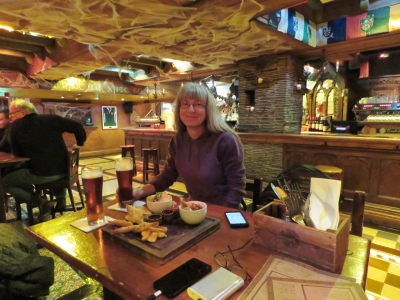 |
10/31/2017: Waxy O'Conners
Position: 53°29.12'N, -2°14.48'W
An excellent lunch at Waxy O'Conners Irish pub in the Printworks.
|
 |
10/31/2017: Football Stars
Position: 53°29.17'N, -2°14.54'W
After lunch, we visited the National Football Museum, a multi-floor venue covering the history of British and world football (soccer to those who would draw a football with two pointed ends).
|
 |
10/31/2017: Bradford Fire
Position: 53°29.15'N, -2°14.53'W
One of the more sobering displays at the National Football Museum covered the many deaths and injuries that have occurred over the decades at football stadiums in the UK and attempts to make the game safer for fans. In the 1985 Bradford City stadium fire, a small fire broke out in litter beneath the wooden grandstands that engulfed the stands above within four minutes. 56 people died and over 256 were injured, many in trying to escape through exit gates and turnstiles that were locked.
|
 |
10/31/2017: Pele
Position: 53°29.15'N, -2°14.54'W
A large exhibit at the museum was devoted to Pele, a Brazilian footballer considered by many to the best player of all time.
|
 |
10/31/2017: Benfica
Position: 53°29.06'N, -2°14.65'W
Benfica was playing Manchester United tonight at Old Trafford stadium just outside the city center. These Benfica fans were cheering outside the old Corn Exchange building while Manchester fans looked on from The Old Wellington. We kept a safe distance while police kept a sharp eye on both groups.
|
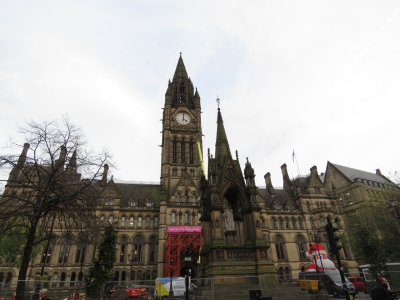 |
10/31/2017: Town Hall
Position: 53°28.78'N, -2°14.73'W
Manchester's striking Town Hall building was completed in 1877.
|
 |
10/31/2017: Bridgewater Hall
Position: 53°28.56'N, -2°14.74'W
Manchester has some beautiful new buildings as well. This is Bridgewater Hall, an international concert venue that opened in 1996 and cost about £42M.
|
 |
10/31/2017: Barbirolli Square
Position: 53°28.56'N, -2°14.74'W
The Barbirolli Square office complex was completed in 2001.
|
 |
10/31/2017: Rain Bar
Position: 53°28.50'N, -2°14.77'W
The Rain Bar on Great Bridgewater St. looked most appealing, but we had already made plans for dinner.
|
 |
10/31/2017: Picadilly Gardens
Position: 53°28.88'N, -2°14.23'W
Adults and children alike were playing in the fountain at Picadilly Gardens.
|
 |
10/31/2017: El Capo
Position: 53°28.87'N, -2°13.92'W
Manchester has been a major manufacturing center since the Industrial Revolution. Many things were made there, including Jennifer. She was born in Manchester on October 31st and this is her first time back since leaving at aged two. We had an excellent birthday celebration dinner at El Capo.
|
 |
10/31/2017: O2 Apollo
Position: 53°28.17'N, -2°13.33'W
The highlight of our birthday celebration for Jennifer was tickets at the famous O2 Apollo theater for Kaleo, a band we've recently started to really enjoy. The wall behind the bar lists the history of the theatre including many of the famous bands that have played here such as the Beatles, the Rolling Stones, the Who, Bruce Springsteen and Oasis.
|
 |
10/31/2017: Judah & the Lion
Position: 53°28.17'N, -2°13.32'W
The backup band for Kaleo, Judah & the Lion, had an incredibly energetic lead singer and put on an unusally good performace for a backup band.
|
 |
10/31/2017: Kaleo
Position: 53°28.17'N, -2°13.33'W
The sound quality at O2 Apollo is excellent and Kaleo played an astoundingly good show. It seemed to be upgrade day for us—we had purchased balcony seats about three rows from the front and to the right of center, but when we arrived to pick them up the person at the box office said they'd upgraded us and we had center, front-row balcony seat. We're pretty sure these are the best two seats in the house.
|
 |
10/31/2017: Iceland
Position: 53°28.17'N, -2°13.33'W
Kaleo is from Iceland, and recently relocated to the US. But they retain strong Icelandic roots and their stage set features several images of the outline of Iceland. We had a fabulous evening and really enjoyed the show.
|
 |
11/1/2017: Baby
Position: 53°28.63'N, -2°15.28'W
Manchester has an excellent Museum of Science and Industry. A real highlight for us was a working replica of Baby, a tube-based computer developed at Manchester University that in 1948 was the first computer to store and run a program. We spent ages talking with the knowledgeable volunteers who were demonstrating it. Between 1947 and 1977, Manchester University pioneered a number of computer developments including the world's first transistorised computer. The program has personal relevance for us—Jennifer's father Stan Clark earned a PhD in Computer Science while working on the Manchester Atlas computer that in 1962 was the fastest in the world.
|
 |
11/1/2017: Power Hall
Position: 53°28.62'N, -2°15.30'W
Power Hall at the Manchester Museum of Science and Industry houses one of the largest collections of working steam engines in the world, most made in Manchester and many still working.
|
 |
11/1/2017: Oxnoble
Position: 53°28.59'N, -2°15.26'W
After spending most of the morning at the Manchester Museum of Science and Industry, we stopped off at nearby Oxnoble for a delicious lunch.
|
 |
11/1/2017: Air and Space Hall
Position: 53°28.60'N, -2°15.24'W
After lunch, we toured the Manchester Museum of Science and Industry's Air and Space Hall, featuring road and air transportation craft pioneered in Manchester. Exhibits included the work of Manchester-born inventor Alliot Verdon Roe, who in 1910 founded A V Roe and Company (known as Avro) that became a leading British aircraft design company.
|
 |
11/1/2017: Mills
Position: 53°28.64'N, -2°15.32'W
19th-century Manchester supported a booming textile industry. We watched a working demonstration on historic mill machinery showing how cotton was transformed from raw material to calico cloth. The machines are impressively loud and dangerous.
|
 |
11/1/2017: Old Trafford
Position: 53°27.79'N, -2°17.46'W
Manchester United is among the most popular football clubs in the world with the second highest average attendance of all European football clubs after German team Borussia Dortmund. We took an excellent tour of their famous stadium, Old Trafford and learned much about the history of this esteemed club.
|
 |
11/1/2017: Locker Room
Position: 53°27.76'N, -2°17.53'W
The Old Trafford stadium tour took us into the Manchester United locker room, which was surprisingly small and spartan compared to what we've seen of US NFL locker rooms.
|
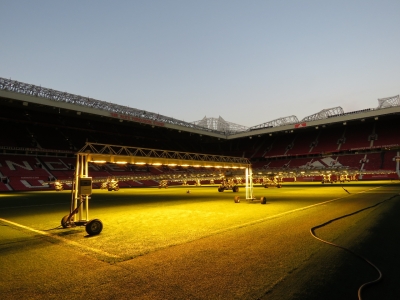 |
11/1/2017: Grow Lights
Position: 53°27.77'N, -2°17.52'W
The sun had set by the time we finished our tour, highlighting the grow lights on the field at Old Trafford. Even though the stadium is open-air, Manchester just doesn't get enough sunshine for the grass to grow well.
|
 |
11/1/2017: Australasia
Position: 53°28.80'N, -2°14.95'W
An excellent meal at Australasia in the Spinningfields District before returning to Liverpool that evening. The Spinningfields District is a relatively new pedestrian mall full of retail stores, offices and restaurants.
|
 |
11/1/2017: Greengate Square
Position: 53°29.12'N, -2°14.74'W
The fountain at Greengate Square near the Manchester train station. Manchester is a beautiful city and we had a wonderful visit.
|
 |
11/2/2017: North Sea Logistics
Position: 53°23.36'N, -2°59.06'W
We moved the boat this morning to a new berth because there wasn't any power close by on our original assingment. Based on the pictures we'd seen of Liverpool Marina, showing canal boats and small pleasure craft, we were expecting Dirona feel a little out of place as the largest boat in the marina. But several large North Sea commercial boats berth there as well. This is North Sea Logistics Endeavour and Endurance. Endeavour is about to be lifted out at Bluepoint Marine Services.
|
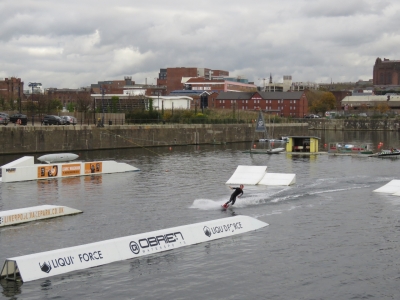 |
11/2/2017: Wake Park
Position: 53°23.52'N, -2°59.30'W
The entire downtown Liverpool waterfront is a series of interconnected enclosed docks once used for commercial traffic. The original docks and locks are too small for most commercial shipping vessels and now are used mainly for pleasure craft and smaller commercial boats. One of the docks has been converted into the Liverpool Wake Park where an overhead cable pulls wakeboarders back and forth as though pulled by a high-horsepower runabout, but at a fraction of the cost.
|
 |
11/2/2017: Zebu
Position: 53°24.11'N, -2°59.49'W
The tall ship Zebu moored alongside Canning Dock, looking west. The ship was built in Sweden in 1938 and worked as a trading vessel until the 1960s. Repairs were recently completed after the ship sunk in 2015 while moored here.
|
 |
11/2/2017: Pump House
Position: 53°24.10'N, -2°59.50'W
We had lunch with an excellent view to Canning Dock at the Pumphouse pub, a restored 1870s pump house.
|
 |
11/2/2017: Downtown Liverpool
Position: 53°24.11'N, -2°59.54'W
Looking east across Canning dock to downtown Liverpool. The city is a beautiful mix of the old restored docks and structures, with more modern buildings all around.
|
 |
11/2/2017: Albert Dock
Position: 53°24.07'N, -2°59.65'W
Looking south across Albert Dock, ringed with restaurants. Many pleasure craft are moored here, and the location is pretty appealing.
|
 |
11/2/2017: Low Tide
Position: 53°24.11'N, -2°59.71'W
This is why Liverpool built the enclosed docks behind locks: at low tide the Mersey River is just exposed mud for a long way out.
|
 |
11/2/2017: View South
Position: 53°24.12'N, -2°59.70'W
The view south across Canning Dock. The Pump House where we had lunch is on the left, Albert Dock is behind the buildings at center, and the Freijwheel Wheel Of Liverpool extends above the buildings on the right.
|
 |
11/2/2017: Three Graces
Position: 53°24.22'N, -2°59.80'W
Liverpool has been a major shipping center since the 1700s and by the early 19th century 40% of the world's trade passed through its ports. The wealthy city built some impressive buildings in the early 1900s, including these known as the "Three Graces". From left to to right are Royal Liver, the Cunard and the Port of Liverpool buildings. Atop the Royal Liver Building are two 5.5m copper statues of the Liver Bird, the city's symbol.
|
 |
11/2/2017: Museum of Liverpool
Position: 53°24.26'N, -2°59.79'W
The striking modern Museum of Liverpool building near the Three Graces. The waterway underneath is the Liverpool Canal Link connecting the Liverpool docks with the Leeds and Liverpool Canal.
|
 |
11/2/2017: Ice Cream
Position: 53°24.26'N, -2°59.81'W
Jennifer hasn't had a soft cone with a flake and reaspberry sauce from a British ice cream truck since visiting relatives in Yorkshire over thirty years ago.
|
 |
11/2/2017: Fab Four
Position: 53°24.27'N, -2°59.79'W
Liverpool is perhaps most famous as the home of the Beatles. This larger-than-life statue near the Three Graces is one of many tributes to the Fab Four.
|
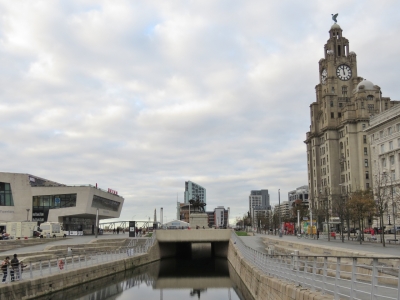 |
11/2/2017: Liverpool Canal Link
Position: 53°24.22'N, -2°59.75'W
Looking north along the Liverpool Canal Link with the Museum of Liverpool on the left and the Three Graces on the right. The link was completed in 2008 to relink the downtown docks with the Leeds and Liverpool Canal. The original connection had been filled in for the construction of the Three Graces
|
 |
11/2/2017: Titanic
Position: 53°24.01'N, -2°59.43'W
One of the canal boats moored at Salthouse Dock is a scaled-down model of the Titanic, tastefully finished off to look like it's sinking.
|
 |
11/2/2017: Wall
Position: 53°24.00'N, -2°59.31'W
This wall alongside Salthouse Dock was built in 1980 with stone from the 1855 warehouse that once stood here.
|
 |
11/2/2017: Freijwheel Wheel
Position: 53°23.91'N, -2°59.44'W
Looking up to the Freijwheel Wheel Of Liverpool adjacent to Dukes Dock. The transportable wheel is 196ft (60 m) tall and weighs 365 tonnes.
|
 |
11/2/2017: St Kilda
Position: 53°23.90'N, -2°59.47'W
A display along the Liverpool waterfront of aerial photograpsh from throughout the UK included this one of dramatic St. Kilda off the Outer Hebrides. We recognized it immediately from our visit there a couple of months ago.
|
 |
11/2/2017: Brunswick Lock
Position: 53°23.21'N, -2°59.04'W
Looking from Brunswick Lock at low tide to what is left of the Mersey River. It's hard to believe Dirona was in that channel three nights ago.
|
 |
11/2/2017: Liverpool Marina
Position: 53°23.21'N, -2°59.05'W
The view across Brunswick Lock to Liverpool Marina with downtown Liverpool visible in the distance. Dirona's blue deck lights are visible through the lock gate. It's a really beautiful setting. We'd moved again this monrning, to a third berth, after the marina decided Bluepoint Marine Services needed more space in the channel in front of their lift area.
|
 |
11/3/2017: Current
Position: 53°23.51'N, -2°59.34'W
This buoy is nearly being pulled under in the strong Mersey River current.
|
 |
11/3/2017: The Beatles Story
Position: 53°23.95'N, -2°59.51'W
You can't go to Liverpool without visiting to the Beatles Story, a museum devoted to the band's Liverpool roots and rise to fame. This is a replica of the famous Cavern Club in downtown Liverpool, the Beatles home club where they played 275 times.
|
 |
11/3/2017: OPP
Position: 53°23.95'N, -2°59.51'W
As longtime Toronto, Ontario residents, this OPP (Ontario Provincial Police) patch on Paul McCartney's "Sgt. Pepper's Lonely Hearts Club Band" jacket caught our attention. Apparently the real Sgt. Pepper was an OPP officer who ran the Beatles' security detail during a 1966 visit to Toronto and one of Pepper's officers gave the band the patch that appears on McCartney's sleeve.
|
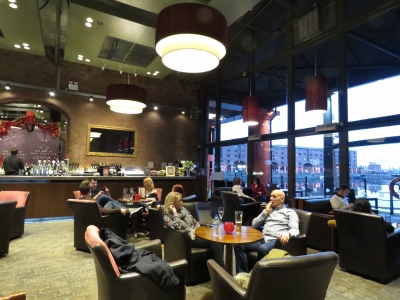 |
11/3/2017: Miller & Carter
Position: 53°23.98'N, -2°59.47'W
After the Beatles Story, we stopped in for a drink in the bar at Miller & Carter overlooking Albert Dock.
|
 |
11/3/2017: Albert Dock
Position: 53°23.98'N, -2°59.47'W
Looking north across Albert Dock at dusk. The Liverpool waterfront sure is beautiful.
|
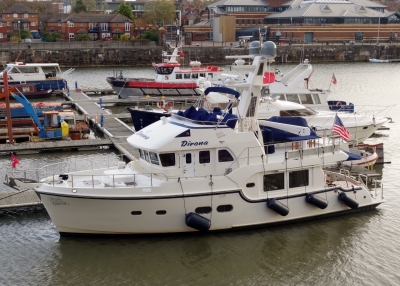 |
11/4/2017: Dirona
Position: 53°23.28'N, -2°59.02'W
Liverpool residents Martin and Mary Sloman sent us this picture they took of Dirona moored below their house, saying it was a nice change from the wind turbine boats they normally see.
|
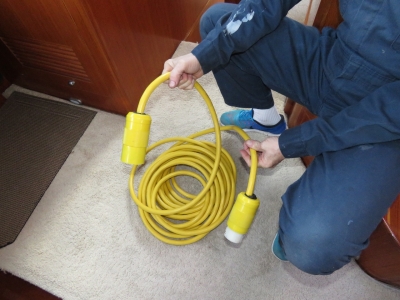 |
11/4/2017: Power Cable
Position: 53°23.28'N, -2°59.02'W
We have 90ft of heavy 50A cable but when we arrived in Liverpool, it was just not quite long enough for where we were originally moored. So James made up another 50ft of cable this morning.
|
 |
11/4/2017: Chinatown Gate
Position: 53°23.98'N, -2°58.57'W
The ornate gate to Liverpool's Chinatown, the oldest Chinese community in Europe.
|
 |
11/4/2017: Congregational Church
Position: 53°23.98'N, -2°58.57'W
Liverpool's Great George Street Congregational Church opened in 1841 and was designated a World Heritage Site in 1952. The church was converted into the community arts building formally nicknamed The Blackie and now officially named The Black-E.
|
 |
11/4/2017: Liverpool Cathedral
Position: 53°23.94'N, -2°58.44'W
Liverpool Cathedral towers over the city from St. James Mount—we can clearly see it from the marina nearly a mile away. It's the largest church in Britain, and the fifth largest church in the world. Construction began in 1904 and was finally completed in 1978. Early funding was largely through private donations from wealthy Liverpool residents during the height of the city's commercial shipping success.
|
 |
11/4/2017: Interior
Position: 53°23.85'N, -2°58.40'W
It's hard to convey in a picture how massive Liverpool Cathedral is inside. The central aisle height is 166ft (35m) and the internal length of the building is 160 yards (150m), more than 50% larger than an American football field.
|
 |
11/4/2017: Organ
Position: 53°24.13'N, -2°58.60'W
With 9,765 pipes, the Liverpool Cathedral organ likely is the largest operational organ in the world.
|
 |
11/4/2017: High Altar
Position: 53°23.83'N, -2°58.38'W
The beautiful High Altar in Liverpool Cathedral.
|
 |
11/4/2017: Lady Chapel
Position: 53°24.22'N, -2°58.77'W
The Lady Chapel was the first part of the church completed, in 1910. The chapel is as big as a medium-sized church, but is perhaps a tenth the size of Liverpool Cathedral.
|
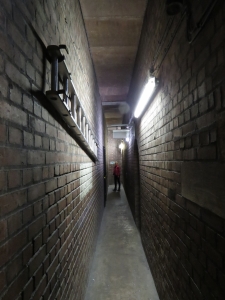 |
11/4/2017: Central Tower
Position: 53°23.86'N, -2°58.41'W
Liverpool Cathedral's tower is 331 ft (101m ) high, making it among the world's tallest non-spired church buildings. Through a series of hallways, stairs and elevators, visitors can climb to the top for panoramic views of the city.
|
 |
11/4/2017: Peal
Position: 53°23.86'N, -2°58.41'W
Looking down onto the Liverpool Cathedral bell peal as we make our way up the tower. The main bell weighs 14.7 tonnes and the thirteen-bell peal is the heaviest in the world at 16.8 tonnes.
|
 |
11/4/2017: Downtown Liverpool
Position: 53°23.85'N, -2°58.40'W
The view from the top of the Liverpool Cathedral tower is impressive. This is looking to downtown Liverpool with Canning Dock at the far left and the Museum of Liverpool and the Three Graces left of center.
|
 |
11/4/2017: Liverpool Marina
Position: 53°23.85'N, -2°58.39'W
Dirona moored at Liverpool Marina viewed from the Liverpool Cathedral tower.
|
 |
11/4/2017: Metropolitan Cathedral
Position: 53°23.84'N, -2°58.40'W
The Roman Catholic Metropolitan Cathedral, just north of Liverpool Cathedral.
|
 |
11/4/2017: Tower
Position: 53°23.85'N, -2°58.38'W
Enjoying the visit to Liverpool Cathedral.
|
 |
11/4/2017: Bombed Out Church
Position: 53°24.10'N, -2°58.49'W
St. Luke's Church, known as the Bombed Out Church, is a former Anglican parish that was badly damaged in World War II by German bombs during the 1941 Liverpool Blitz. It was never restored and now is a memorial to those lost in the war and also is used for events and functions.
|
 |
11/4/2017: Legends
Position: 53°24.40'N, -2°59.19'W
We watched Liverpool Football Club play that night downstairs at Legends in downtown Liverpool. The city has a reputation for being a bit rough, particularly around football matches, but it was a great game in a good atmosphere.
|
 |
11/4/2017: Cavern Club
Position: 53°24.39'N, -2°59.27'W
On our way home we passed the iconic Cavern Club, the Beatles home club where they played 275 times.
|
 |
11/4/2017: Fireworks
Position: 53°23.28'N, -2°59.02'W
We've been seeing fireworks from the marina for the past few days. Tomorrow is Guy Fawkes Night, the anniversary of the failed November 5th, 1605 attempt to bomb the English parliament. Annual celebrations on that date include big bonfires and fireworks displays.
|
 |
11/5/2017: Race Day
Position: 53°23.28'N, -2°59.02'W
Perhaps a dozen sailboats left Liverpool Marina this Sunday morning. They fit as many as possible through together in the first locking, and at least two more groups went through after.
|
 |
11/5/2017: Dirona
Position: 53°23.29'N, -2°59.01'W
We took this picture of Dirona at Liverpool Marina as we headed out to watch the Bonfire Night fireworks.
|
 |
11/5/2017: Wheel
Position: 53°23.90'N, -2°59.49'W
The Freijwheel Wheel Of Liverpool adjacent to Dukes Dock looks awesome at night.
|
 |
11/5/2017: Albert Dock
Position: 53°23.91'N, -2°59.49'W
Albert Dock all lit up for the season, with the lights reflecting into Dukes Dock. The Liverpool waterfront really is beautiful.
|
 |
11/5/2017: Bonfire Night
Position: 53°24.06'N, -2°59.70'W
Thousands of people lined the Mersey River in downtown Liverpool to take in the Bonfire Night fireworks. Bonfire Night, or Guy Fawkes Night, is the anniversary of the failed November 5th, 1605 attempt to bomb the English parliament. Annual celebrations on that date include big bonfires and fireworks displays throughout the UK. We've also seen Guy Fawkes Night celebrated in New Zealand.
|
 |
11/5/2017: Fireworks
Position: 53°23.84'N, -2°59.56'W
The Liverpool Bonfire Night was among the best fireworks shows we've ever seen. Matching displays were fired from a pair of barges moored in the Mersey River just off downtown Liverpool. We really enjoyed the show.
|
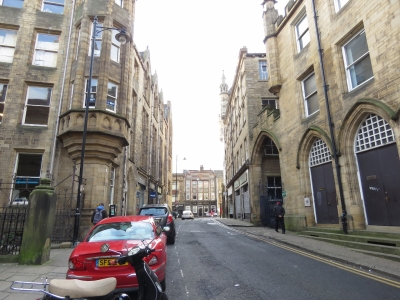 |
11/7/2017: Huddersfield
Position: 53°38.86'N, -1°47.01'W
Looking down Station Street in Huddersfield, where we'd stopped en route between Liverpool and York. Huddersfield is the 11th largest city in Britain and was a prominent textile center during the Industrial Revolution. The town is known for its beautiful Victorian buildings, built at the peak of its economic prosperity, and for being the birthplace of rugby league.
|
 |
11/7/2017: Betty & Dennis Carney
Position: 53°38.82'N, -1°46.91'W
The reason we'd stopped off in Huddersfield was to meet Jennifer's aunt and uncle, Betty and Dennis Carney, who live in nearby Yorkshire. We've not seen them since they visited us in Seattle years ago—it was great to catch up.
|
 |
11/7/2017: York Station
Position: 53°57.49'N, -1°5.64'W
When the current York station opened in 1877 with 13 platforms, it was the largest railway station in the world.
|
 |
11/7/2017: The Duke of York
Position: 53°57.49'N, -1°5.57'W
We stopped off for a quick lunch at the Duke of York pub at York station.
|
 |
11/7/2017: National Railway Museum
Position: 53°57.62'N, -1°5.77'W
We spent the rest of the afternoon at the superb National Railway Museum in York. It is the largest railway museum in the world with over 100 locomotives on display. This is overlooking the Great Hall, where most of the locomotives are housed around a working turntable.
|
 |
11/7/2017: Mallard
Position: 53°57.62'N, -1°5.77'W
Inside the cab of the the Mallard, one of the featured locomotives at the York National Railway Museum. In 1938, the Mallard set the world steam locomotive speed record at 126mph (203 kph), a record that still stands.
|
 |
11/7/2017: Chunnel
Position: 53°57.62'N, -1°5.76'W
A replica of the Chunnel (Channel Tunnel between England and France) at the York National Railway Museum.
|
 |
11/7/2017: Archives
Position: 53°57.65'N, -1°5.75'W
The National Collection at the York National Railway Museum includes over 2 million objects, with shelves and shelves of railway memorabilia in its archives area.
|
 |
11/7/2017: The Works
Position: 53°57.61'N, -1°5.71'W
Looking down into The Works where workers maintain the York National Railway's collection of locomotives and carriages, often making parts from scratch. In the foreground is the 1937 steam locomotive Sir Nigel Gresley, whose namesake designed some of the most famous British steam engines, including the Flying Scotsman.
|
 |
11/7/2017: Micklegate Bar
Position: 53°57.34'N, -1°5.46'W
13th-century York was a walled city and much of that original wall still survives. On our way to dinner we'll pass through Micklegate Bar, one of several gatehouses along the wall ("bar" is an ancient term for gatehouse).
|
 |
11/7/2017: River Ouse
Position: 53°57.60'N, -1°5.23'W
Looking south along the River Ouse from the Station Road bridge in York. The Romans founded York in AD 71—the site being ideal for a fortress because the river provided access to the North Sea. Today you can take a sightseeing tour boat along the river, a pastime popular since 1840.
|
 |
11/7/2017: Stonegate
Position: 53°57.62'N, -1°5.05'W
York has a beautiful downtown, with modern shops and restaurants opening from narrow cobblestone streets. The is the night lights reflecting in wet cobblestone on Stonegate.
|
 |
11/7/2017: Banyan
Position: 53°57.63'N, -1°4.99'W
We had a good meal at Banyan Bar and Kitchen on Little Stonegate in downtown York.
|
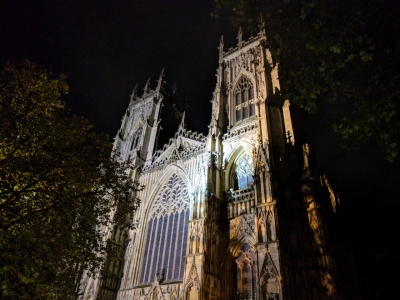 |
11/7/2017: York Minster
Position: 53°57.72'N, -1°5.02'W
We could hear the bells pealing at York Minster, so walked over to have a look. We'll be visiting the famous cathedral tomorrow.
|
 |
11/7/2017: Guy Fawkes
Position: 53°57.71'N, -1°4.99'W
Guy Fawkes, who plotted to blow up the English Parliament in 1606, was born in York in 1570. The Guy Fawkes Inn stands on the spot where he was born.
|
 |
11/7/2017: City Wall
Position: 53°57.56'N, -1°5.32'W
Most of the York City Wall is closed at night for safety reasons, but a portion west of the River Ouse was still open when we returned from dinner. We plan to walk the full wall tomorrow.
|
 |
11/8/2017: Micklegate Bar
Position: 53°57.35'N, -1°5.46'W
Micklegate Bar is one of four main gates through the York City Wall, and the most important. Several monarchs have passed through the gate, stopping by tradition to ask the Lord Mayor's permission to enter the city. The lower section was built in the 12th century and the upper in the 14th. The severed heads of executed rebels and traitors were displayed here for many centuries—the last was removed in 1754.
|
 |
11/8/2017: City Wall
Position: 53°57.47'N, -1°5.49'W
The York City Walls date from the 13th century and are the most complete medieval city walls in England. By the late 18th century, most English cities had demolished their walls because they were no longer needed for defense and the walls obstructed traffic and hindered expansion. The Corporation of York almost did the same, but met with intense local opposition and instead preserved and restored them. This is looking northeast along the wall a short distance west of Micklegate Bar with York Minster visible as the leftmost building in the distance.
|
 |
11/8/2017: York Minster
Position: 53°57.50'N, -1°5.47'W
The 235 ft (72 m) central tower 196 ft (60 m) western towers of York Minster stand high above the rest of the city. A church was built on this site as early as 627. Several successive structures were destroyed or damaged and the present minster, one of the largest medieval cathedrals in Northern Europe, was built mainly between 1220 and 1480.
|
 |
11/8/2017: Nave
Position: 53°57.74'N, -1°4.99'W
York Minster is among the most beautiful Gothic buildings in the world. The magnificent nave pictured here was built in the late 13th century and is roofed in wood painted to look like stone, allowing for a higher and wider area than stone construction. The ceiling soars 99 ft (30m) above the floor.
|
 |
11/8/2017: West Window
Position: 53°57.74'N, -1°4.99'W
The Great West Window, installed in 1338, is the most impressive of York Minster's many beautiful medieval stained glass window. It is known as the "Heart of Yorkshire" because of the heart-shaped stone tracery in the upper stonework.
|
 |
11/8/2017: Rose Window
Position: 53°57.74'N, -1°4.97'W
7,000 pieces of glass make up the circular Rose Window high in the gable of the South Transept. The window commemorates the union of the royal houses of York and Lancaster, who battled for control of the throne during the fifteenth-century in a conflict known as the "War of the Roses".
|
 |
11/8/2017: Five Sisters
Position: 53°57.74'N, -1°4.92'W
The Five Sisters dates from the 13th century and is the oldest complete window in York Minster.
|
 |
11/8/2017: King's Screen
Position: 53°57.74'N, -1°4.91'W
The 15th-century King's Screen is one of the most well-known parts of York Minster. The screen separates the nave from the choir and includes statues of English kings ranging from William the Conqueror to Henry VI.
|
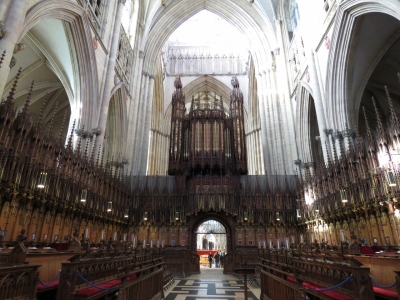 |
11/8/2017: Choir
Position: 53°57.74'N, -1°4.91'W
Looking west through the intricately-carved wooden choir stalls. The detail in the carvings is amazing.
|
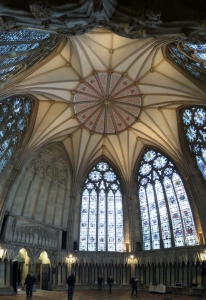 |
11/8/2017: Chapter House
Position: 53°57.75'N, -1°4.89'W
The octagonal Chapter House in York Minster was built in the 13th century. Unlike similar structures of its time, the vaulted ceiling has no central support column and is instead supported by an innovative external roof structure.
|
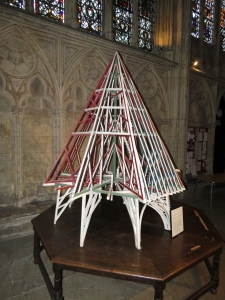 |
11/8/2017: Support
Position: 53°57.75'N, -1°4.89'W
This model of the Chapter House roof shows the complex timber structure, nearly twice the height of the structure, from which the vaulted ceiling is suspended.
|
 |
11/8/2017: Doomstone
Position: 53°57.75'N, -1°4.90'W
York Minster was built on the site of an earlier Norman Minster from which this 12-century doomstone was recovered. The stone depicts "Hell's Cauldron" with devils and demons pushing lost souls into a boiling cauldron.
|
 |
11/8/2017: Steps
Position: 53°57.71'N, -1°4.96'W
Jennifer visited York Minster several times during childhood trips to England from Canada and was eager to return. She particularly remembered climbing the 275-step circular staircase to the top of the central tower and was delighted to learn this was still open to the public.
|
 |
11/8/2017: Nave Roof
Position: 53°57.72'N, -1°4.93'W
The staircase to the central tower crosses an outdoor balcony with a close-up views to the nave roof and its supporting structure, and the west towers beyond.
|
 |
11/8/2017: Central Tower
Position: 53°57.73'N, -1°4.94'W
Looking west across the nave roof to the west towers from the York Minster central tower.
|
 |
11/8/2017: Kilburn White Horse
Position: 53°57.74'N, -1°4.93'W
The 318-ft (97 m) by 220 ft (67 m) Kilburn White Horse hill figure viewed from the York Minster central tower. The figure, cut into the hill in 1857, is believed to be the largest hill figure in England.
|
 |
11/8/2017: Houses
Position: 53°57.73'N, -1°4.92'W
Tightly-packed houses jam York's narrow and winding streets.
|
 |
11/8/2017: Drax Power
Position: 53°57.73'N, -1°4.92'W
The cooling towers of Drax coal power station, visible 20 miles away from York Minster. The station generates about 7-8% of the UK's power.
|
 |
11/8/2017: East Windows
Position: 53°57.75'N, -1°4.86'W
The Great East Window was completed in the early 1400s and contains the largest single expanse of medieval stained glass in the world, measuring 76ft (23.3m) high and 31ft (9.5m) wide.
|
 |
11/8/2017: Lund's Court
Position: 53°57.63'N, -1°4.88'W
Lund's Court is one of many narrow alleyways between York's twisting streets.
|
 |
11/8/2017: Lunch
Position: 53°57.56'N, -1°5.03'W
A late lunch with a street view at All Bar One on New Street in downtown York. Luckily, we picked the table that matched Jennifer's sweater.
|
 |
11/8/2017: The Shambles
Position: 53°57.59'N, -1°4.81'W
The Shambles, with 15th century Tudor buildings overhanging the street, reminded us of the road where Harry Potter bought his school supplied in the Sorcerer's Stone movie.
|
 |
11/8/2017: City Wall North Corner
Position: 53°57.86'N, -1°4.88'W
After lunch, we returned to the City Wall at the River Ouse to complete the circuit. These arches in the wall were created as part of a reconstruction in Victorian times. They wouldn't have been particularly useful in a defensive wall.
|
 |
11/8/2017: Roman Fortress
Position: 53°57.72'N, -1°4.62'W
The Romans founded York in AD 71 and built a fortress here. These are some of the ruins of that fortress, viewed from the York City Wall.
|
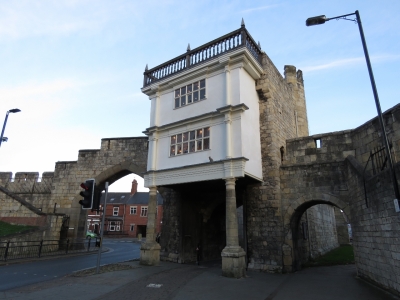 |
11/8/2017: Walmgate Bar
Position: 53°57.31'N, -1°4.26'W
Several cafes are built into the wall. This one is at Walmgate Bar, one of the four main gatehouses through the original wall.
|
 |
11/8/2017: River Foss
Position: 53°57.27'N, -1°4.67'W
Reflections in still water along York's second waterway, the River Foss.
|
 |
11/8/2017: Clifford's Tower
Position: 53°57.31'N, -1°4.81'W
Clifford's Tower, just inside the York City Wall, is one of the few obvious remnants of 13th-century York Castle.
|
 |
11/8/2017: BrewDog
Position: 53°57.38'N, -1°5.41'W
After completing our circuit of the wall, we stopped off for a drink at BrewDog near Micklegate Bar. The street-side bar seat and the spartan setting reminded us of Unfiltered Brewing in Halifax, Canada.
|
 |
11/8/2017: Dinner
Position: 53°57.63'N, -1°5.00'W
We finished the day at Gusto, with an excellent meal under their fabulous light-studded crawling vine.
|
 |
11/9/2017: St. George's Hall
Position: 53°24.47'N, -2°58.76'W
Striking St George's Hall, opposite Liverpool's Lime Street Station, was built in the 1800s as a concert hall and courthouse. Initially two separate building were to be constructed, but the same designer won the bid for both and suggested combining them to create one large building that would be bigger than most other public buildings in the country at that time.
|
 |
11/9/2017: Queen Victoria
Position: 53°24.31'N, -2°59.38'W
A monument to Queen Victoria in downtown Liverpool was unveiled in 1906. The statue amazingly survived the World War II Liverpool Blitz when most of the area was destroyed by German bombs.
|
 |
11/9/2017: Maritime Museum
Position: 53°24.09'N, -2°59.58'W
We were looking forward to visiting the Merseyside Maritime Museum and learning more about the city's growth and nautical history, but unfortunately many of the exhibits we were interested in were under construction and closed. We did enjoy the World War I and II exhibits though.
|
 |
11/9/2017: Albert Dock
Position: 53°24.06'N, -2°59.55'W
The view to Albert Dock from their cafe might have been our favourite part of the Merseyside Maritime Museum.
|
 |
11/9/2017: Philharmonic
Position: 53°24.12'N, -2°58.22'W
We stopped of for a drink at the fabulous Philharmonic bar, designed by the Lusitania shipwrights and considered one of the most beautiful bars in the country.
|
 |
11/9/2017: Loo
Position: 53°24.10'N, -2°58.22'W
Even the loo at the Philharmonic is beautiful—its the country's only heritage-listed bathroom.
|
 |
11/9/2017: Hard Wok Cafe
Position: 53°24.11'N, -2°58.35'W
We loved the name of this Chinese food restaurant.
|
 |
11/10/2017: KVH
Position: 53°24.38'N, -2°59.44'W
The KVH Media Group is based in Liverpool and since we're both KVH satellite communication users and known to enjoy technology, they invited us up to their office to meet the team and have lunch. From left to right are Stephanie Whitehead, Rob Parkin and Jamie Broadbent. We appreciated Jamie's invitation to come learn more about KVH systems.
|